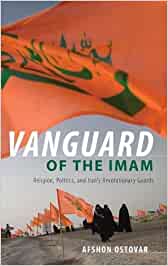There is an important element of novelty in the Vanguard of the Imam by Afshon Ostovar, mainly an English-speaking account of the powerful - both economically and politically - Iran´s Revolutionary Guards (IRGC).
In the author´s words, IRGC is ´a multifaceted organisation with reach into many different areas. It is a security service, an intelligence organisation, a social and cultural force, and a complex industrial and economic conglomerate. It is foremost a military organization´.
The main question the book wants to answer is: ´What is the IRGC and what makes it such a domineering force in Iran and such an influential player in the Middle East? ´
The author uses historical details and contemporary aspects, trying to build a relatively clear landscape where the IRGC operates both internally and externally, particularly its journey towards becoming the strongest political actor in Iran, with its own naval and air forces, among others. All wrapped into a very unique religious interpretation which makes it an interesting - for the political science scholar, but deadly poisonous for those actually depending on it - case study for the mixture between politics and strict religious perspective.
The religious activism extends beyond the country´s border, influencing and creating conflict all around the region, but particularly in relation with Israel.
Although it goes deep into the ideological and religious roots of this unique organisation, it does not explores further the movement in itself. For instance, a question that at least for me remains unanswered is what is the sociological basis of IRGC, what are the biographies of the members of this hybrid elite? Another important element which is missing, in my opinion, is the evaluation of the extent of the economic outreach which eventually may be an element to keep in mind in the case of a regime change. As it happened in many former communist countries, the control of economic resources by the representatives of the regime continued for a very long time after the political end of the regimes, which created, as in the case of the former Soviet Union, the well known phenomenon of ´moguls´.
Clearly, the access to the information regarding both the structure of the assets and of the elites is very limited, and those aspects can be further explored. Those shortcoming do not affect the novelty and the rich documentary material used in this book. New angles and approaches will definitely help further research and analysis on topics that are very important for the study of the region as well as of Iran in general.

No comments:
Post a Comment